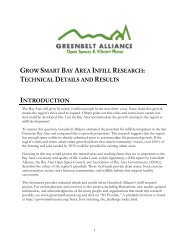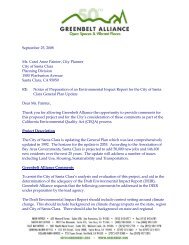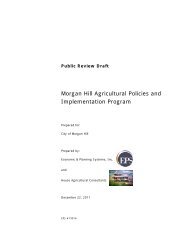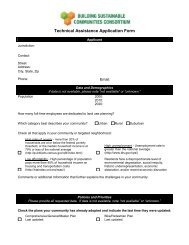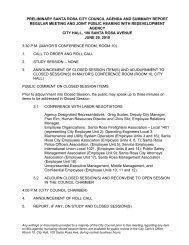Create successful ePaper yourself
Turn your PDF publications into a flip-book with our unique Google optimized e-Paper software.
Methods<br />
The <strong>2006</strong> <strong>At</strong> <strong>Risk</strong> report is based on the analysis<br />
of data collected in 2005.<br />
Defining <strong>Risk</strong><br />
As in previous editions, the <strong>2006</strong> <strong>At</strong> <strong>Risk</strong> report<br />
divides the Bay Area’s land into five categories:<br />
ü High risk: <strong>Greenbelt</strong> lands that, for a variety of<br />
factors cited below, are likely to be developed or<br />
taken out of greenbelt uses (such as productive<br />
agriculture, open space, wildlife habitat, and<br />
recreation areas) in the next 10 years.<br />
ü Medium risk: <strong>Greenbelt</strong> lands that are likely to be<br />
developed or taken out of greenbelt uses in the<br />
next 30 years. Rural lands that are parcelized<br />
for rural residential uses are also considered<br />
medium-risk lands, since these uses generally<br />
preclude productive farming and create<br />
conditions that favor eventual suburban sprawl.<br />
ü Low risk: <strong>Greenbelt</strong> lands that, for a variety of<br />
policy, geographic, or political reasons, are not<br />
likely to be developed in the next 30 years.<br />
ü Secure greenbelt: <strong>Greenbelt</strong> lands that are<br />
permanently protected from development,<br />
including most public lands, land trust<br />
properties, conservation easements, and private<br />
lands that are securely protected by a vote of<br />
the people. Most city parks and open spaces are<br />
not included in the secure greenbelt because<br />
data from some cities was not available at the<br />
time the maps were created.<br />
ü Urban: Lands that are developed at a density of<br />
at least one residential dwelling unit per 1.5<br />
acres, or the equivalent structure density for<br />
commercial or industrial development.<br />
<strong>Risk</strong> Factors<br />
ü Approved or proposed development: <strong>Greenbelt</strong><br />
lands that have already been approved for<br />
development or are the object of a current<br />
development proposal, are considered at-risk.<br />
A current development proposal means that a<br />
landowner has formally applied for relevant<br />
development or construction permits, applied<br />
for a zoning change, or otherwise made public<br />
the intention to develop the land (or sell it to<br />
someone who will develop it).<br />
ü Designation in a city or county General Plan or zoning<br />
code: A given land area is considered at-risk if it<br />
is zoned or otherwise designated in a General<br />
Plan for residential, commercial or industrial<br />
development at densities of more than one unit<br />
per 1.5 acres, or the equivalent structure density<br />
for commercial or industrial development.<br />
ü Historical development threat: A given land area<br />
may be considered at-risk if it has previously<br />
been the object of development proposals or<br />
applications, or is the subject of ongoing legal or<br />
political conflict about its development<br />
potential, and no policies are in place to prevent<br />
its development.<br />
ü Inside relevant urban limits: A given land area is<br />
considered at-risk if it is within city limits,<br />
within an urban growth boundary, or within a<br />
city’s sphere of influence (i.e., its planned area of<br />
future expansion). Good development on these<br />
lands is preferable to development outside city<br />
boundaries, and can help to protect the region’s<br />
greenbelt as a whole. However, these lands are<br />
still at risk of sprawl development.<br />
ü Adjacent to existing development: A given land<br />
area is considered at risk if it is directly adjacent<br />
to land that is already developed, proposed for<br />
development, or approved for development at a<br />
density of at least one unit per 1.5 acres, and<br />
there are no policies in place to prevent its<br />
development.<br />
ü Infrastructure services: given land area is<br />
considered at risk if it already has direct access<br />
to municipal water and sewer services, and no<br />
policies are in place to prevent its development.<br />
ü Regional transportation access: A given land area<br />
is considered at risk if it has access to the<br />
regional transportation network (either roads or<br />
transit), or is in an area that will be made<br />
accessible by adopted local and regional<br />
transportation plans, and no policies are in<br />
place to prevent its development.<br />
ü Parcelization: A given land area is considered at<br />
risk if parcel sizes are 5 acres or smaller, and no<br />
policies are in place to prevent its development.<br />
ü Development speculation: A given land area is<br />
considered at risk if it has been offered at prices<br />
commensurate with its development value, as<br />
opposed to its agricultural value, and there are<br />
no policies in place to prevent its development.<br />
ü Topography: A given land area’s risk appraisal<br />
may be altered (in either direction) based on the<br />
physical feasibility of development given the<br />
slopes and soil stability.<br />
ü Other risk factors: Some areas are at-risk due to<br />
proposals for development projects that are not<br />
included in adopted city, county or regional<br />
plans. Examples of such development include<br />
military bases, casinos, stadiums, educational<br />
campuses, and energy plants.<br />
In general, high-risk lands are characterized by<br />
buildable terrain, proximity to existing urban<br />
areas and transportation infrastructure,<br />
designation as developable in a county or city<br />
general plan, and/or development speculation.<br />
Medium-risk lands share many of these factors,<br />
but often to a lesser degree. Medium-risk lands<br />
are generally farther away from existing urban<br />
areas. Additionally, lands that are at risk of<br />
parcelization, but lack any other risk factor, are<br />
considered medium-risk lands. Lands that are at<br />
risk from any of the above factors, but are<br />
protected from development by a given policy, are<br />
classified as at-risk if that policy is likely to expire<br />
and open those lands to development within the<br />
next 10 years (high risk) or 30 years (medium risk).<br />
<strong>Risk</strong> Assessment<br />
<strong>Risk</strong> analysis was undertaken in 2005 by<br />
<strong>Greenbelt</strong> <strong>Alliance</strong> field staff, each of whom is<br />
familiar with development issues in two Bay Area<br />
counties. The field staff consulted all relevant city<br />
and county planning and zoning documents, as<br />
well as other maps issued by relevant government<br />
Table 4: Adjusted 2000 <strong>At</strong>-<strong>Risk</strong> Findings<br />
High-<strong>Risk</strong><br />
Acres<br />
Medium-<strong>Risk</strong><br />
Acres<br />
Low-<strong>Risk</strong><br />
Acres<br />
agencies, to precisely identify which land areas<br />
are subject to the risk factors identified above. In<br />
addition, staff consulted with city and county<br />
planners, agency officials, and <strong>Greenbelt</strong> <strong>Alliance</strong><br />
associates to gather additional information.<br />
Urban and Permanently Protected Lands<br />
The State of California’s Farmland Mapping and<br />
Monitoring Project provided the base map of<br />
urbanized areas, based on satellite images of the<br />
San Francisco Bay Area in 2001 and 2002. Secure<br />
greenbelt lands were mapped by the Bay Area<br />
Open Space Council in early 2005. <strong>Greenbelt</strong><br />
<strong>Alliance</strong> field staff made limited updates to both<br />
the urban and secure greenbelt map layers to<br />
account for notable changes that occurred before<br />
October 2005. The lands defined by these two<br />
data layers were not subjected to risk analysis.<br />
Mapping Methods<br />
For the risk assessment, <strong>Greenbelt</strong> <strong>Alliance</strong> staff<br />
evaluated and mapped individual “risk zones,”<br />
geographic units of analysis that vary in size.<br />
Some units are as small as a single individual<br />
parcel; some are clusters of parcels that are at risk<br />
for the same reason.<br />
The risk maps were digitized and tiled together<br />
using the Geographic Information System (GIS)<br />
software ArcGIS 9.1, to create a regional<br />
composite map. From this composite map,<br />
regional and county-by-county summary data<br />
were calculated. This map also formed the basis of<br />
comparison with the 2000 data. The GIS also<br />
facilitated calculation of the changes in the<br />
geographic extent of various risk categories, the<br />
fate of previously at-risk lands, and the<br />
proportion of land at risk due to a given risk<br />
factor, at both at the regional and county level.<br />
Comparing 2000 and <strong>2006</strong><br />
Significant improvements in mapping techniques<br />
over the last 5 years required that the 2000 spatial<br />
data be adjusted in order to be exactly comparable<br />
with that of <strong>2006</strong>. The datasets mapped in<br />
the 2000 report for urban land and open space<br />
were replaced with more accurate datasets for<br />
2000 issued by the Farmland Mapping and<br />
Monitoring Project and the Bay Area Open Space<br />
Council, respectively. After the changes were<br />
made, the geographic extent of various risk<br />
categories in 2000 was recalculated to allow accurate<br />
comparison with <strong>2006</strong>. Therefore, the total<br />
acreages reported in this document for 2000 differ<br />
from those of the 2000 <strong>At</strong> <strong>Risk</strong> report (Table 4).<br />
Urban<br />
Acres<br />
Protected<br />
Acres<br />
Total<br />
Acres*<br />
Alameda 25,000 11,000 212,500 141,400 95,100 485,000<br />
Contra Costa 54,300 46,100 127,300 142,200 99,100 469,100<br />
Marin 5,300 2,500 131,400 40,500 159,400 339,000<br />
Napa 17,900 1,100 369,300 21,100 76,000 485,300<br />
San Francisco 0 0 600 24,400 5,300 30,300<br />
San Mateo 7,900 10,700 111,200 71,100 91,400 292,400<br />
Santa Clara 37,400 58,100 410,000 184,100 147,800 837,300<br />
Solano 39,900 56,500 346,200 53,800 35,100 531,500<br />
Sonoma 25,700 64,800 770,000 70,700 84,800 1,016,000<br />
Total 213,300 250,800 2,478,500 749,300 794,000 4,486,000<br />
Note: Rows and columns may not add up precisely due to rounding.<br />
*Acreage totals exceed actual land area due to slight overlap between the GIS layer of urban lands prepared by the State of<br />
California’s Farmland Mapping and Monitoring Project, the GIS layer of protected lands prepared by the Bay Area Open Space<br />
Council, and the GIS layer of water from GreenInfo Network. The total error due to overlap is approximately 1.3%.<br />
28 <strong>At</strong> <strong>Risk</strong>: The Bay Area <strong>Greenbelt</strong>




